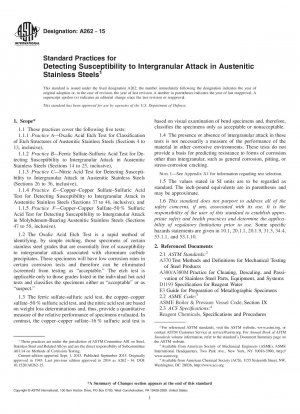ASTM A262-15
Standard Practices for Detecting Susceptibility to Intergranular Attack in Austenitic Stainless Steels
- Standard No.
- ASTM A262-15
- Release Date
- 2015
- Published By
- American Society for Testing and Materials (ASTM)
- Status
- Replace By
- ASTM A262-15(2021)
- Latest
- ASTM A262-15(2021)
- Scope
6.1 Use of the etch test allows rapid acceptance of specific lots of material without the need to perform time-consuming and costly hot acid immersion tests on those lots.
1.1 These practices cover the following five tests:
1.1.1 Practice A—Oxalic Acid Etch Test for Classification of Etch Structures of Austenitic Stainless Steels (Sections 4 to 13, inclusive),
1.1.2 Practice B—Ferric Sulfate-Sulfuric Acid Test for Detecting Susceptibility to Intergranular Attack in Austenitic Stainless Steels (Sections 14 to 25, inclusive),
1.1.3 Practice C—Nitric Acid Test for Detecting Susceptibility to Intergranular Attack in Austenitic Stainless Steels (Sections 26 to 36, inclusive),
1.1.4 Practice E—Copper–Copper Sulfate–Sulfuric Acid Test for Detecting Susceptibility to Intergranular Attack in Austenitic Stainless Steels (Sections 37 to 46, inclusive), and
1.1.5 Practice F—Copper–Copper Sulfate–508201;% Sulfuric Acid Test for Detecting Susceptibility to Intergranular Attack in Molybdenum-Bearing Austenitic Stainless Steels (Sections 47 to 58, inclusive).
1.2 The Oxalic Acid Etch Test is a rapid method of identifying, by simple etching, those specimens of certain stainless steel grades that are essentially free of susceptibility to intergranular attack associated with chromium carbide precipitates. These specimens will have low corrosion rates in certain corrosion tests and therefore can be eliminated (screened) from testing as “acceptable.” The etch test is applicable only to those grades listed in the individual hot acid tests and classifies the specimens either as “acceptable” or as “suspect.”
1.3 The ferric sulfate-sulfuric acid test, the copper–copper sulfate–508201;% sulfuric acid test, and the nitric acid test are based on weight loss determinations and, thus, provide a quantitative measure of the relative performance of specimens evaluated. In contrast, the copper–copper sulfate–168201;% sulfuric acid test is based on visual examination of bend specimens and, therefore, classifies the specimens only as acceptable or nonacceptable.
1.4 The presence or absence of intergranular attack in these tests is not necessarily a measure of the performance of the material in other corrosive environments. These tests do not provide a basis for predicting resistance to forms of corrosion other ......
ASTM A262-15 Referenced Document
- ASTM A370 Standard Test Methods and Definitions for Mechanical Testing of Steel Products
- ASTM A380/A380M Standard Practice for Cleaning, Descaling, and Passivation of Stainless Steel Parts, Equipment, and Systems*, 2024-04-20 Update
- ASTM D1193 Standard Specification for Reagent Water
- ASTM E3 Standard Practice for Preparation of Metallographic Specimens
- ISO 3651-2 Determination of resistance to intergranular corrosion of stainless steels - Part 2: Ferritic, austenitic and ferritic-austenitic (duplex) stainless steels - Corrosion test in media containing sulfuric acid
ASTM A262-15 history
- 2021 ASTM A262-15(2021) Standard Practices for Detecting Susceptibility to Intergranular Attack in Austenitic Stainless Steels
- 2015 ASTM A262-15 Standard Practices for Detecting Susceptibility to Intergranular Attack in Austenitic Stainless Steels
- 2014 ASTM A262-14 Standard Practices for Detecting Susceptibility to Intergranular Attack in Austenitic Stainless Steels
- 2013 ASTM A262-13 Standard Practices for Detecting Susceptibility to Intergranular Attack in Austenitic Stainless Steels
- 2010 ASTM A262-10 Standard Practices for Detecting Susceptibility to Intergranular Attack in Austenitic Stainless Steels
- 2002 ASTM A262-02a(2008) Standard Practices for Detecting Susceptibility to Intergranular Attack in Austenitic Stainless Steels
- 2002 ASTM A262-02ae3 Standard Practices for Detecting Susceptibility to Intergranular Attack in Austenitic Stainless Steels
- 2002 ASTM A262-02ae2 Standard Practices for Detecting Susceptibility to Intergranular Attack in Austenitic Stainless Steels
- 2002 ASTM A262-02ae1 Standard Practices for Detecting Susceptibility to Intergranular Attack in Austenitic Stainless Steels
- 2002 ASTM A262-02a Standard Practices for Detecting Susceptibility to Intergranular Attack in Austenitic Stainless Steels
- 2002 ASTM A262-02 Standard Practices for Detecting Susceptibility to Intergranular Attack in Austenitic Stainless Steels
- 2001 ASTM A262-01 Standard Practices for Detecting Susceptibility to Intergranular Attack in Austenitic Stainless Steels
- 1998 ASTM A262-98 Standard Practices for Detecting Susceptibility to Intergranular Attack in Austenitic Stainless Steels

Copyright ©2024 All Rights Reserved